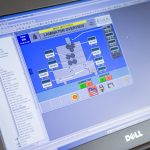Buildings are made up of more than just the concrete walls and floors that specialty contractors provide. Underneath the surface of the conduits, wires, ductwork, and electrical and mechanical systems are formulas, regulations, data, and efficiencies that weave together to create hospitals, high-rises, stadiums, schools, offices, and more. Before they are translated to the jobsite, these factors are carefully put together by teams of engineers and craftspeople who are strategizing new ways to improve the quality and safety of the work done on the jobsite.
Engineering practices in the construction industry have evolved significantly since the turn of the century, with new efficiencies and opportunities presenting themselves every day. From virtual construction to prefabrication, more construction projects are being completed off-site than ever before. The jobsite, which used to be a centralized location where everything was built, has now evolved to become a receiving area where pre-engineered and pre-fabricated products are staged and assembled. Taking advantage of these practices is essential for modern project demands, optimizing efficiencies, timelines, budgets, and job site safety.
VIRTUAL PROBLEM-SOLVING
One of the first “construction sites” a project goes through is a virtually simulated computerized model known as virtual design construction (VDC). Egan’s engineers are taking advantage of VDC capabilities to streamline design and improve the entire build process. For more than two decades, VDC has become the tool of choice for the engineering industry, acting as the canvas on which engineers can work and create a model of their final product.
By beginning with VDC technologies in the early stages of projects, teams can identify project and material needs, potential hazards, and solutions before any work begins onsite. Building Information Modeling (BIM) software, Computer Aided Design (CAD) technology, and other systems enable Egan’s VDC teams to get ahead of the curve, maintain safety and accuracy on the job site, and prevent delays in the building process.
ENGINEERING SOLUTIONS
The benefits of engineering can be measured by the reduction of total labor hours, costs, and project timelines in conjunction with an increase in the quality of work. By engaging with Egan’s engineers early on in projects, the estimating and proposal processes can be exponentially more efficient and accurate thanks to the systems and software in place. This can also set a firm foundation for efficient prefabrication processes later in the project.
Engineering technology at Egan is not necessarily Artificial Intelligence (AI), though it looks like it on the surface level. Made up of formulas, spreadsheets, and efficiencies, engineering softwares can calculate and assess material, design, timeline, and budget requirements with high accuracy. Incorporating smart engineering can help predict the labor hours needed on projects or tasks, problems that may occur, or other considerations that can be planned for and solved ahead of time.
PREFABRICATION: THE NEW INDUSTRY STANDARD
Prefabrication is a standard practice utilized across many of Egan’s trades, and is becoming one of the primary construction sites for any project within the industry. InterClad, Egan’s glass and glazing team, has benefitted from the safety and efficiency of prefabrication since its founding in 1998. Egan’s Mechanical pipefitter teams are able to complete welds and piece together larger parts of projects within a controlled environment, utilizing custom CAD drawings to guide the fabrication process. Egan’s plumbing shop and control panel shop also utilize prefabrication to complete as much of the work as possible independently of the field site, to increase efficiency and safety at all stages of the project.

A prefabrication facility eliminates jobsite waste or excess labor that may come as a result of working in the field. This enables prefabrication experts to receive plans from trades professionals in the field and engineers and put them into action without slowing down the work on the project. Egan’s recent electrical work on the 568,000 square foot FedEx Distribution Facility in Rosemount, Minn. utilized nearly 3,500 hours of prefabrication work, which resulted in significant cost savings, as well as a reduced risk of injuries and mistakes on the jobsite. The dedicated team completed much of the repetitive or harder-to-complete work in a controlled environment before sending the ready-to-install materials to Rosemount.
The prefabrication team is taking quality one step further at Egan by documenting and double-checking the quality checkpoints of each build. These checkpoints are printed on a sheet with a unique QR code that is attached to each build. In the field, the QR code can be scanned by any field personnel to provide feedback/comments via a Google Form that provides an easy method for tracking, resolving, and improvements that are made in association with the comments.
THE FUTURE OF PREFABRICATION
The industry continues to evolve with these engineering practices; prefabrication is quickly becoming a larger operation where teams assemble whole sections of projects in a separate controlled environment independent of the final jobsite. Egan is finding solutions to improve the work we do while maintaining safety and quality at every step.
Egan sets high standards and goals annually for the number of prefabrication hours that are logged each year. This number directly correlates to the success of projects, revenue, and the entire operational efficiency across each of Egan’s 12 multi-trade expertise. Additional prefabrication capabilities are on the horizon at Egan, with the investment of a new 40,000 square foot facility that will primarily focus on electrical prefabrication being built in Southern Minnesota. As the construction industry continues to evolve, Egan strives to be at the forefront, ready to find solutions that help our customers in every way possible.

